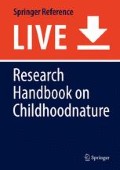Abstract
The purpose of this chapter is to assemble a theoretical toolkit, a greedy bag of possibilities, that can enable childhood-nature encounters to flourish in the Anthropocene and beyond. In this undertaking, our aim is not to put diverse theoretical perspectives into competition with each other but rather to assemble theories as tools which can produce sparks when knocked together. These are theories that can be packed up and taken for a walk. Theories that can help us to get out of sticky situations. And theories which children themselves can use to address the crises which they will inevitably inherit (and already are). As such, this theory-infused section seeks to put multiple philosophical perspectives into consequential relations such that they can become productive in their directions and differences. In this chapter we take stock of theories that have been productive in the field childhood-nature up to this point, while at the same time seeking new theories, which are emerging in direct response to the contemporary planetary turn.
References
Barad, K. (2012, June). Intra-actions: An interview with Karen Barad by Adam Kleinman. Mousse, #34, 76–81.
Barad, K. (2014). Diffracting diffraction: Cutting together-apart. Parallax, 20(3), 168–187.
Chandler, D. (2013). The world of attachment? The post-humanist challenge to freedom and necessity. Millennium – Journal of International Studies, 41(3), 516–534.
Colebrook, C. (Ed.). (2010). Extinction: Framing the end of the species. London, UK: Open Humanities Press.
Deleuze, G., & Guattari, F. (1987/2014). A thousand plateaus. (Translated and a foreword by B. Massumi). London, England: Bloomsbury.
Derrida, J. (2005). On touching–Jean-Luc Nancy. Stanford, CA: Stanford University Press.
Duhn, I., Malone, K., & Tesar, M. (2017). Troubling the Intersections of urban/nature/childhood in environmental education. Environmental Education Research, 23(10), 1357–1368. https://doi.org/10.1080/13504622.2017.1392486
Haraway, D. (2011). SF: Science fiction, speculative fabulation, string figures, so far. Viewed Jan 30 2014. http://people.ucsc.edu/~haraway/Files/PilgrimAcceptanceHaraway.pdf.
Haraway, D. (2015). Anthropocene, Capitalocene, Plantationocene, Chthulucene: Making kin. Environmental Humanities, 6(1), 159–165. http://environmentalhumanities.org.
Haraway, D. (2016). Staying with the trouble. Making kin in the Chthulucene. Durham, NC/London, England: Duke University Press.
Harman, G. (2002). Tool-being: heidegger and the metaphysics of objects. Open Court: Chicago, IL.
Harman, G. (2011). The quadruple object. Winchester, UK/Washington, DC: Zero Books.
Harman, G. (2013). Bells and whistles: More speculative realism. Winchester, UK/Washington, DC: Zero Books.
Head, L. (2016). Hope and grief in the anthropocene: Re-conceptualising human–nature relations. London, UK: Routledge
Koro-Ljungberg, M. (2015). Reconceptualizing qualitative research: Methodologies without methodologies. London, England: Sage.
Louv, R. (2005). Last child in the woods: Saving our children from nature-deficit disorder. Chapel Hill, NC: Algonquin Books.
Malone, K. (2017). Children in the Anthropocene: Rethinking sustainability and child friendliness in cities. London, England: Palgrave.
Malone, K., & Waite, S. (2016). Student outcomes and natural schooling: Pathways from evidence to impact report. Plymouth, UK: Plymouth University. Retrieved from https://www.plymouth.ac.uk/uploads/production/document/path/6/6811/Student_outcomes_and__natural_schooling_pathways_to_impact_2016.pdf. https://doi.org/10.13140/RG.2.1.3327.7681.
Morton, T. (2007). Ecology without nature: rethinking environmental aesthetics. Cambridge, MA: Harvard University Press
Morton, T. (2010). The ecological thought. Cambridge, MA: Harvard University Press
Morton, T. (2013). Hyperobjects: Philosophy and ecology after the end of the world. Minneapolis, MN: University of Minnesota Press.
Morton, T. (2016). Dark Ecology. For a logic of future coexistence. New York, NY: Columbia University Press
Quay, J. (2017). From human–Nature to cultureplace in education via an exploration of unity and relation in the work of Peirce and Dewey. Studies in Philosophy and Education, 36, 463–476.
Taylor, A., Blaise, M., & Guigni, M. (2013). Haraway’s ‘bag lady story-telling’: Relocating childhood and learning within a ‘post-human landscape’. Discourse: Studies in the Cultural Politics of Education, 34(1), 48–62.
Van der Tuin, I. (2014). Diffraction as methodology as feminist onto-epistemology: On encountering chantal and chawaf and posthuman interpellation. Parallax, 20(3), 231–244.
Waite, S. (2013). Knowing your place in the world: How place and culture support and obstruct educational aims. Cambridge Journal of Education, 43(4), 413–433.
Waite, S. (2015). Culture clash and concord: Supporting early learning outdoors in the UK. In H. Prince, K. Henderson, & B. Humberstone (Eds.), International handbook of outdoor studies. London, England: Routledge.
Author information
Authors and Affiliations
Corresponding author
Editor information
Editors and Affiliations
Section Editor information
Rights and permissions
Copyright information
© 2018 Springer International Publishing AG, part of Springer Nature
About this entry
Cite this entry
Malone, K., Duhn, I., Tesar, M. (2018). Greedy Bags of Childhoodnature Theories. In: Cutter-Mackenzie, A., Malone, K., Barratt Hacking, E. (eds) Research Handbook on Childhoodnature . Springer International Handbooks of Education. Springer, Cham. https://doi.org/10.1007/978-3-319-51949-4_3-1
Download citation
DOI: https://doi.org/10.1007/978-3-319-51949-4_3-1
Received:
Accepted:
Published:
Publisher Name: Springer, Cham
Print ISBN: 978-3-319-51949-4
Online ISBN: 978-3-319-51949-4
eBook Packages: Springer Reference EducationReference Module Humanities and Social SciencesReference Module Education
Publish with us
Chapter history
-
Latest
Greedy Bags of Childhoodnature Theories- Published:
- 04 January 2019
DOI: https://doi.org/10.1007/978-3-319-51949-4_3-2
-
Original
Greedy Bags of Childhoodnature Theories- Published:
- 05 April 2018
DOI: https://doi.org/10.1007/978-3-319-51949-4_3-1

